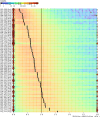A New Comparative Framework for Estimating Selection on Synonymous Substitutions
- PMID: 40129111
- PMCID: PMC11979333
- DOI: 10.1093/molbev/msaf068
A New Comparative Framework for Estimating Selection on Synonymous Substitutions
Abstract
Selection on synonymous codon usage is a well-known and widespread phenomenon, yet existing models often do not account for it or its effect on synonymous substitution rates. In this article, we develop and expand the capabilities of multiclass synonymous substitution (MSS) models, which account for such selection by partitioning synonymous substitutions into 2 or more classes and estimating a relative substitution rate for each class, while accounting for important confounders like mutation bias. We identify extensive heterogeneity among relative synonymous substitution rates in an empirical dataset of ∼12,000 gene alignments from 12 Drosophila species. We validate model performance using data simulated under a forward population genetic simulation, demonstrating that MSS models are robust to model misspecification. MSS rates are significantly correlated with other covariates of selection on codon usage (population-level polymorphism data and tRNA abundance data), suggesting that models can detect weak signatures of selection on codon usage. With the MSS model, we can now study selection on synonymous substitutions in diverse taxa, independent of any a priori assumptions about the forces driving that selection.
Keywords: codon substitution models; codon usage bias; molecular evolution; synonymous substitutions.
© The Author(s) 2025. Published by Oxford University Press on behalf of Society for Molecular Biology and Evolution.
Figures








Update of
-
A new comparative framework for estimating selection on synonymous substitutions.bioRxiv [Preprint]. 2025 Feb 6:2024.09.17.613331. doi: 10.1101/2024.09.17.613331. bioRxiv. 2025. Update in: Mol Biol Evol. 2025 Apr 1;42(4):msaf068. doi: 10.1093/molbev/msaf068. PMID: 39975314 Free PMC article. Updated. Preprint.
References
Publication types
MeSH terms
Grants and funding
LinkOut - more resources
Full Text Sources
Molecular Biology Databases

